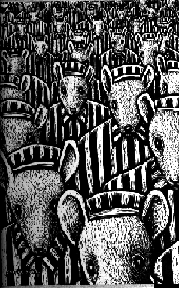
When I first read Courigan I was very confused about how to read the panels correctly. It was not your typical symmetrical panels with the perfectly lined gutters. Not only did the panels not line up but it seemed to me that the content jumped around alot. This was not a comic I found to be a "quick read" by any means. However, once we introduced the idea of ragtime music to the comic it seemed to flow alot better. I found that the way ragtime music jumped around with its high and low pitched sequences was the same way I found my brain taking in the comics information and closures.
Is it possible that music can give a personality to a comic? I found that to be very true since the more I listened to the ragtime clips, the more I found the panels following to the beat of the music in my mind. It seemed to make the panels flow more like a film strip. It also gave it the quirky kind of music that you would assume an old time cartoon would have.
Is it possible that there may be a reason behind the random placement of comic panels? This thought did not occur to me until our group disscussions in class today. One could imagine the gutters of the strip to be the lines of a music scale and the random horizontal and vertical panels to represent musical notes. It takes a little imagination but I think the flow is there. Once I considered this idea it seemed to give alot more movement and noise to the busy streets and buldings of Chicago.
Is it possible that music can give a personality to a comic? I found that to be very true since the more I listened to the ragtime clips, the more I found the panels following to the beat of the music in my mind. It seemed to make the panels flow more like a film strip. It also gave it the quirky kind of music that you would assume an old time cartoon would have.
Is it possible that there may be a reason behind the random placement of comic panels? This thought did not occur to me until our group disscussions in class today. One could imagine the gutters of the strip to be the lines of a music scale and the random horizontal and vertical panels to represent musical notes. It takes a little imagination but I think the flow is there. Once I considered this idea it seemed to give alot more movement and noise to the busy streets and buldings of Chicago.

